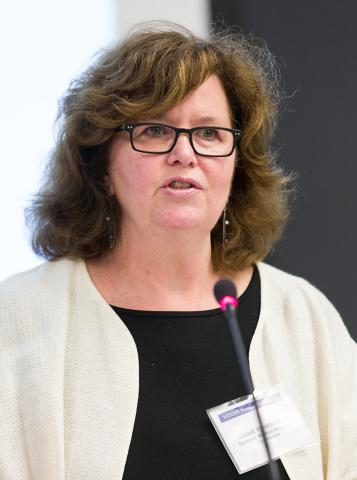NINDS Nonprofit Forum Explores Progress Through Partnership

Photo: Daniel Soñé
NINDS recently held its 11th “Progress Through Partnership” nonprofit forum bringing together more than 130 participants—including representatives from 63 patient advocacy groups from around the country—to learn about NINDS research and funding, network with each other and interact with program staff.
“The purpose of the meeting is two-fold,” said NINDS director Dr. Walter Koroshetz. “First, to listen to the nonprofit organizations and get their input and feedback, and second, to inform them about what we are doing here at NINDS and where their tax dollars go.”
New this year was a pre-forum orientation session for first-time attendees that featured a primer on NINDS research priority-setting, decision-making and NIH basics given by Dr. David Owens of the Division of Extramural Activities and Dr. Ernie Lyons of the Scientific Review Branch. Also on the bill was “A Day in the Life of a Program Director,” by Dr. Jill Morris of the Neurogenetics Cluster.
The forum featured discussions on patient-driven research, access to new drugs for rare neurological disorders, continuity of care and issues and challenges in functional endpoints and neurological scales, which focused on Food and Drug Administration guidance for neurological clinical trials.

Photo: Daniel Soñé
“There is no other area I can think of besides neurology that is so rich with opportunities but so devoid of beneficial therapies,” said panelist Dr. Billy Dunn of FDA’s Center for Drug Evaluation and Research, describing how difficult neurological disorders are to treat. “To be an effective drug, we [at FDA] evaluate how it makes the patient feel, function and survive.”
Throughout the 2-day meeting, nonprofit representatives shared lessons as well as success stories, which ranged from discovering new treatments to achieving therapy readiness.

Photo: Daniel Soñé
“Patient involvement is critical and necessary at every stage of rare diseases research and therapy development,” Pariser said.Dr. Anne Pariser of NCATS and Ron Bartek of the Freidreich’s Ataxia Research Alliance led a presentation on the new, web-based NCATS Toolkit for Patient-Focused Therapy Development. The toolkit, which debuted in September, was created as a one-stop resource to guide patient groups through the therapy development process.
Eric Dishman, director of the All of Us Research Program, provided an in-depth look at NIH’s newest research initiative. All of Us is an effort to gather data from 1 million or more people living in the United States to accelerate research and improve health.
“I became a patient advocate because patient advocates helped me understand what was happening to me,” said Dishman, a 23-year kidney cancer survivor. “At the heart of the All of Us Research Program is a participant-centeredness that undergirds all that we do.”
During the meeting, nonprofit representatives also informally met with NINDS program staff and attended a session featuring 25 posters on key nonprofit initiatives involving the institute.

